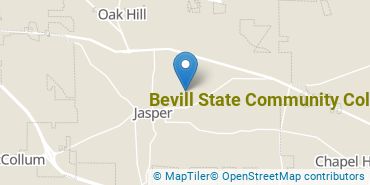Bevill State Community College Trade Programs
Bevill State Community College is a public institution situated in Jasper, Alabama. The location of Bevill State Community College is a good match for students who are interested in living in a college town while they pursue their degree.
Featured schools near , edit
Where Is Bevill State Community College?

Contact details for Bevill State Community College are given below.
| Contact Details | |
|---|---|
| Address: | 1411 Indiana Avenue, Jasper, AL 35501 |
| Phone: | 205-387-0511 |
| Website: | www.bscc.edu |
Can I Afford Bevill State Community College?
| In State | Out of State | |
|---|---|---|
| Tuition | $3,556 | $7,112 |
| Fees | $1,122 | $1,122 |
| Books and Supplies | $1,466 | $1,466 |
| On Campus Room and Board | $4,650 | $4,650 |
| On Campus Other Expenses | $5,113 | $5,113 |
Student Loan Debt
Almost 66% of college students who graduated with the class of 2018 took out student loans, but that percentage varies from school to school. At Bevill State Community College, approximately 2% of students took out student loans averaging $7,767 a year. That adds up to $31,068 over four years for those students.
Bevill State Community College Undergraduate Student Diversity

Gender Diversity
Of the 970 full-time undergraduates at Bevill State Community College, 46% are male and 54% are female.

Racial-Ethnic Diversity
The racial-ethnic breakdown of Bevill State Community College students is as follows.

| Race/Ethnicity | Number of Grads |
|---|---|
| Asian | 1 |
| Black or African American | 94 |
| Hispanic or Latino | 31 |
| White | 800 |
| International Students | 0 |
| Other Races/Ethnicities | 44 |
Bevill State Community College Trade School Concentrations
The table below shows the number of awards for each concentration.
| Major | Basic Certificate | Associate’s | Undergraduate Certificate | TOTAL |
|---|---|---|---|---|
| Truck & Bus Driver/Commercial Vehicle Operator & Instructor | 207 | 0 | 0 | 207 |
| Licensed Practical/Vocational Nurse Training | 0 | 0 | 156 | 156 |
| Electrician | 97 | 38 | 20 | 155 |
| Welding Technology/Welder | 104 | 12 | 10 | 126 |
| Emergency Medical Technology/Technician (EMT Paramedic) | 52 | 3 | 0 | 55 |
| General Drafting & Design Technology | 13 | 12 | 0 | 25 |
| Tool & Die Technology/Technician | 7 | 10 | 5 | 22 |
| General Vehicle Maintenance & Repair Technologies | 10 | 10 | 1 | 21 |
| Surgical Technology | 20 | 0 | 0 | 20 |
| Heating, Ventilation, Air Conditioning & Refrigeration Engineering Technology | 4 | 11 | 2 | 17 |
| Salon/Beauty Salon Management/Manager | 3 | 9 | 0 | 12 |
| Instrumentation Technology | 0 | 1 | 0 | 1 |
| Industrial Mechanics & Maintenance Technology | 0 | 1 | 0 | 1 |
| Manufacturing Engineering Technology | 0 | 0 | 0 | 0 |
| TOTAL | 517 | 107 | 194 | 818 |
References
*The racial-ethnic minorities count is calculated by taking the total number of students and subtracting white students, international students, and students whose race/ethnicity was unknown. This number is then divided by the total number of students at the school to obtain the racial-ethnic minorities percentage.
More about our data sources and methodologies.
Featured Schools
 Request Info
Request Info
|
Southern New Hampshire University You have goals. Southern New Hampshire University can help you get there. Whether you need a bachelor's degree to get into a career or want a master's degree to move up in your current career, SNHU has an online program for you. Find your degree from over 200 online programs. Learn More > |
